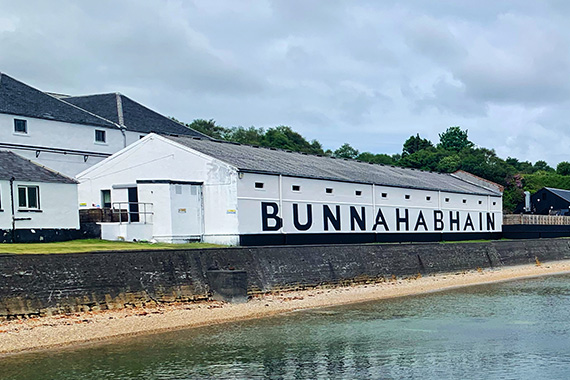Bunnahabhain’s story
Bunnahabhain means ‘mouth of the river’ in the local Gaelic dialect and stands (rather unsurprisingly) on the mouth of the Margadale river where it joins Bunnahabhain Bay on the north-east coast of the western isle of Islay. The distillery overlooks the Sound of Islay, a narrow channel of fast-flowing sea water that separates Islay from the neighbouring island of Jura.
The whisky produced at Bunnahabhain is different to those made on the rest of Islay. It is often non-peated and has none of the rich and smoky flavours of its famous island neighbours. Water from a nearby natural spring is used for production. Having said that, they have been producing a small percentage (around 200,000 litres per year) of peated whisky since the late 1990s and this has become particularly popular and is often used in distillery released limited editions and independent bottling companies.
The whisky also has a pronounced salty tang to it and this comes as a result of the whisky being matured next to the sea and the casks ‘breathing’ in the sea air over time. This is often referred to as being a ‘coastal’ or ‘maritime’ character. Bunnahabhain was exclusively used in blended whiskies until the late 1970s and porevious owners, Burn Stewart Distillers, were the ones to truly concentrate on establishing it as a single malt whisky in the world market. The distillery has been expanded by the current ownership to a 3.5 million litre capacity. This is in order to compensate for sporadic production within the last 25 years or so. The main market for Bunnahabhain single malt is the UK, although it is also popular in America, France and Holland.
Bunnahabhain’s history
Bunnahabhain was founded in 1881 by a co-operative of William Robertson from Robertson & Baxter blending house in Glasgow and brothers William and James Greenlees from the Islay Distillers Company. Despite its isolated location, they were attracted to the site by the abundance of fresh water from nearby Loch Staoinsha and the natural harbour close by that made transportation by sea easier. They had to build a one mile long road to link up the remote site with the island’s main road.
The stone for the distillery buildings was quarried locally and soon the village of Bunnahabhain grew up around the distillery. Full production at Bunnahabhain started in 1883 and in 1887 it became one of the founder members of the Highland Distillers Company Limited. The distillery suffered during the post World War I slump in the whisky industry and was closed between 1930 and 1937. Upon re-opening, the whisky was used by the Highland Distillers Co. Ltd. as the main ingredient for their Black Bottle blended whisky. The demand for Black Bottle grew and in 1963 the number of stills were doubled to four, in order to meet this. The first ever Bunnahabhain single malt was only released during the 1970s and even then it was very limited.
The distillery was closed again between 1982 and 1984 with production particularly sporadic in the years that followed. In 1999, the Edrington Group took over Bunnahabhain from Highland Distillers. They only ran production for a few weeks every year in order to supply single malt whisky for their Famous Grouse blend. In 2003, they sold Bunnahabhain and the Black Bottle name to Burn Stewart Distillers, who rebranded and expanded the ranges of both. Distell, part of the CVH Spirits group, have picked up the baton and continued the trend. The domestic and travel retail ranges have grown even further with sales at a level never previously achieved.
- How to pronounce Bunnahabhain? bun-na-ha-ven
- Country: Scotland
- Region: Islay
- Founded: 1881
- Current owners: Distell (CVH Spirits)
- Production capacity per year: 3.5 million litres
- Mash tun: 12.5 ton
- Washbacks: 6
- Stills: 4
- Visitor centre: Yes
Bunnahabhain Distillery
Port Askaig
Islay
PA46 7RP
tel – +44 (0)1496 840 646
www.bunnahabhain.com
Did you know?
The Black Bottle blended smoky whisky, for which Bunnahabhain contributes the largest percentage, once contained whisky from every distillery on the island of Islay. The recipe has now been changed so this is no longer the case but Bunnahabhain still plays a significant role.
Bunnahabhain


